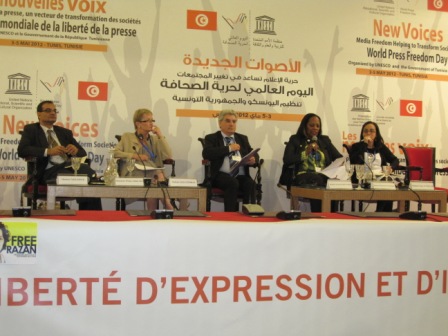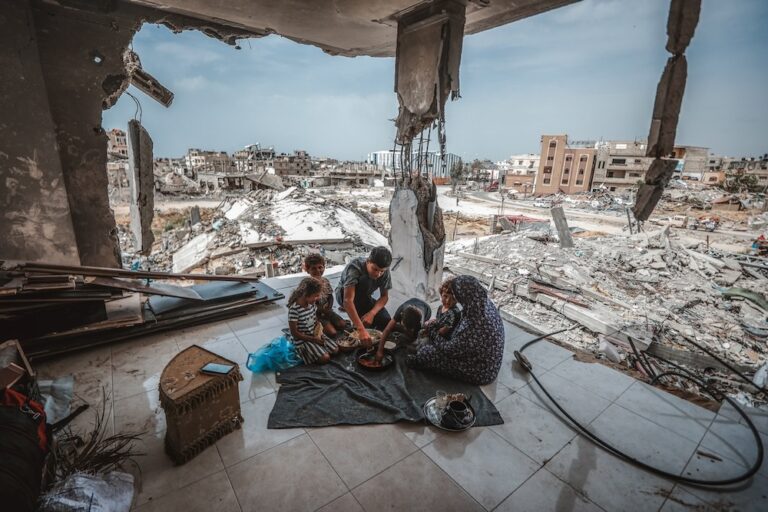Panelists stressed that cooperation with local media, as well as publicity and advocacy efforts are key means to end attacks against journalists.
(IPI/IFEX) – Wednesday, 09 May 2012 – At a panel discussion on “Improving the safety of traditional media workers and new media practitioners,” sponsored by the International Press Institute (IPI) in the course of UNESCO’s World Press Freedom Day conference in Tunis, Tunisia, panellists and other participants sought to identify effective mechanisms to ensure the safety of journalists worldwide.
“Murders and other forms of violence against journalists represent the most serious violations of press freedom,” IPI Executive Director, Alison Bethel McKenzie, who moderated the May 4 discussion, said. She went on to ask panelists: “What can be done to ensure the safety of journalists worldwide? Have we done enough?”
Speaker Owais Aslam Ali, chairman of the Karachi-based Pakistan Press International, pointed out that over 40 journalists were killed in Pakistan in the past five years in connection with their job and many more were assaulted, kidnapped, tortured and threatened, highlighting how dangerous the practice of journalism remains in Pakistan. Nevertheless, Ali also noted that major progresses have been made in the past decades towards the protection of journalists. “Today, attacks against journalists are widely reported; any action that the government takes against press freedom meets with the resistance of the civil society and often governments have to withdraw,” Ali said, stressing the importance of publicity and advocacy in efforts to end violence against journalists.
Moving from Pakistan to Egypt, Lina Attallah, managing editor of Egypt International, the English-language newspaper of Egypt’s Al Masriy Al Youm, recounted that “75% of [her] team of journalists were either beaten or imprisoned” while covering the Egyptian revolution in 2011.
Assessing the efforts of the international community to stop attacks against journalists, Attallah said that international observers focused mainly on English-language media and English-speaking journalists, and the local-language media remain broadly excluded from support and coverage by the international community. “It is extremely important to ensure that organizations documenting attacks against the media speak a diversity of languages,” in order to understand the challenges facing the local-language media, Attallah pointed out.
Speaking on behalf of UNESCO, which has been a driving force behind a recently endorsed UN inter-agency plan of action on journalists’ safety, Sylvie Coudray, chief of section for UNESCO’s Freedom of Expression Division, said that various UN agencies have developed mechanisms to promote journalists’ safety, but greater coordination among them is needed. In the coming months, UNESCO’s efforts will focus on identifying and implementing effective ways to promote journalists’ safety in a concerted manner with UN agencies, other international organisations and civil society groups.
“Violence is, in the great majority of the cases, is displayed towards local media,” panelist Emmanuel Boutterin, vice-president of the World Association of Community Radio Broadcasters (AMARC), said. “In Mexico, the violence is directed against community radios.” Boutterin went on talking about the importance of the “defense mechanisms” set up by UNESCO.
In interventions from the floor, participants also stressed the value of safety training, in particular for journalists who were killed or seriously wounded for being “in the wrong place, at the wrong time.” But safety training is expensive and the great majority of media organizations, in particular local ones in rural areas, cannot afford it.
In closing remarks, Owais Aslam Ali highlighted the close link between professional, ethical journalism and safety. Lina Attallah urged international actors to closely cooperate with local groups who have a thorough knowledge of the situation on the ground and an experience in promoting safety in that specific reality.
In a joint declaration issued at the end of UNESCO’s World Press Freedom Day conference in Tunis, participants called on all stakeholders “to create a safe environment for journalists, media workers and social media producers to produce information through traditional or new media, and to support the implementation of the UN Inter-Agency Plan of Action on The Safety of Journalists and the Issue of Impunity.”
The UN Inter-Agency Plan of Action was endorsed by the UN Chief Executive Board on April 13, 2012, with the aim of creating a safe environment for journalists and media workers in both conflict and non-conflict situations.



